I recently provided a post on a very upbeat PwC report on innovation and its growing importance to growth in the coming years. The PwC report “Breakthrough innovation and growth” was a survey of 1,757 C-suite and executive respondents, on their thoughts on innovation and where the new growth was coming from in approach.
The top line was companies are seeing innovation transforming their businesses and their need to take a more sophisticated approach to innovation, so as to achieve the growth plans they are setting for the next five years.
There was a strong indication that the innovation that was going to be pursued was going to follow a far more radical set of innovation practices that have the potential for offering a real impact on companies future growth ambitions.
Yet I have also been reading another report issued by Corporate Executive Board (CEB), a leading members-based advisory company called “Growth Readiness- prioritizing investments to drive executive commitment” discussing the secret to effective investment prioritization is demonstrating your organization’s readiness to pursue growth. (N.B You need to fill out the form to obtain the report)
Both correlate on the strong need for growth. CEB suggests as the global growth has stalled that in response, companies have planned to boost non-incremental growth investments by almost two-thirds.
The CEB defines non-incremental investment as a large growth opportunity that requires some change to the business.
The PwC report enthuses about innovation and reports
“Growth is a top priority for most (80%) of the companies we interviewed and their plans are ambitious. Executives are planning for 35.4% growth, on average, over the next five years, the equivalent of 6.2% per year. Over a quarter of executives (26%) say that they are aiming for ‘aggressive growth’ over the next five years”
Yet there are dark clouds of concern in the Strategic Office
Yet in a associate blog from CEB written by Marc Austin, who has primary responsibility for research and product research at CEB, he discusses one big if not huge issue that will hold any investment decisions back, and this lies clearly in the board room.
“When I talk with heads of strategy – mostly, they talk about their frustration with the C-suite. Strategists describe the senior executives in their organizations as analytical, tenacious, and gifted in the art of getting things done. Yet the growing trend across boardrooms is indecision, especially when it comes to deciding on big, higher-risk growth bets.
As one strategist explained, “I only had head-nods, not real commitment.” This isn’t just a problem. It’s a big problem… At the end of the day, it’s getting executives to follow through, to defend their decision, to ensure funding and resourcing for the big bets happen and don’t get derailed. Without commitment, there is really no point to strategy.”
There are some serious issues seemingly raised around strategy according to the CEB report..
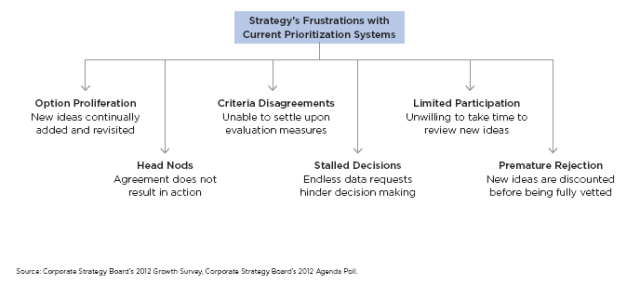 One of the critical points within the CEB report is suggesting that the lack of commitments to non-incremental investment can cost a company 3.25% less return (above hurdle rate), or a 34% lower profit than they might
One of the critical points within the CEB report is suggesting that the lack of commitments to non-incremental investment can cost a company 3.25% less return (above hurdle rate), or a 34% lower profit than they might
So do we sense we might be having a real problem here?
It seems a real tension is occurring between desire and reality? Between strategic intent and follow through? Certainly this will be between how innovation is intended to lead growth through the strategic intent? The CEB report discusses the important changes taking place around risk and talks about risk readiness.
Is innovation riding in to offset risk?
Yet in a further PWC recent study: Unleashing the power of innovation, three quarters(74%) of CEOs regard innovation as equally important to the success of their company as operational effectiveness, if not more. This is the first time in recent history that innovation has been in parity with operations in the C-suite.
The latest PwC report on breakthrough innovation and growth goes on to mention that “the push to create new value is not so surprising in itself. What is most surprising is that in this challenging economic climate, where many companies still face enormous pressures to reduce costs and become more efficient, many executives are telling us they see innovation on a par with operational effectiveness”.
If these ambitious rates of growth are to be achieved, companies recognise that they will need to look beyond the more traditional options for growth, such as mergers and acquisitions and traditional R&D.

It does seem broader types of innovation might have finally arrived in the boardroom. There seems in CEO’s minds a clear correlation between innovation and growth.
PwC point out “The widespread rejuvenation of innovation should have a profound impact on the way businesses plan for the future”. The leading innovators in their study are targeting a higher proportion of breakthrough and radical innovations, particularly around products, services, technology and business models
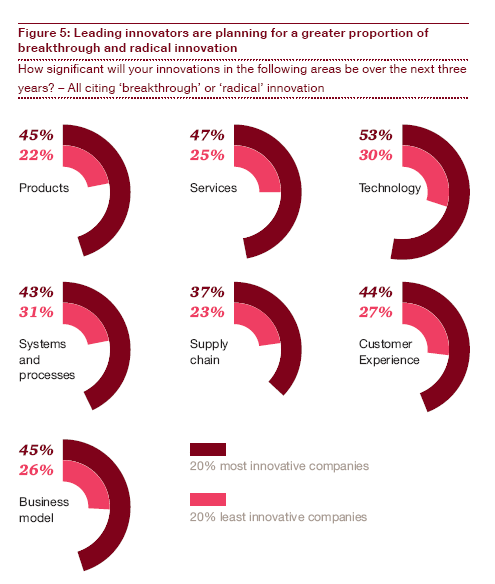
PwC does caution companies, “they need to determine whether they should adopt a ‘Play to Win’ or a ‘Play Not to Lose’ innovation strategy. ‘Play Not to Lose’ is a defensive posture appropriate for groups that are risk-averse or unable to be leaders that generate winning innovations. In some competitive environments this makes sense: it is better to play conservatively and avoid taking large risks” (pg24).
Companies are looking across the innovation cycle to get into the right shape to implement this shift in strategy towards a very high organic growth one and be able to execute on innovation.
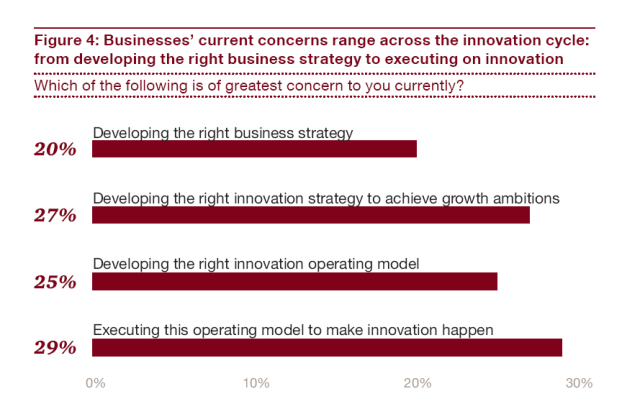
With acceptance that growth gaps need resolving it seems risk will raise its head.
Will business leaders overcome their current higher concerns for taking risk and will that come from more radical innovation? It seems this is a very open question. There seems a desire to ‘talk up’ innovation, to leverage it more but the reality of managing the risk seems the issue that needs managing.
Yet recent market changes have altered how executives make decisions and develop commitment.Prior to the recession, commitment could be captured on the basis of the opportunity’s inherent attractiveness.Today the basis of commitment to major growth bets has fundamentally changed.
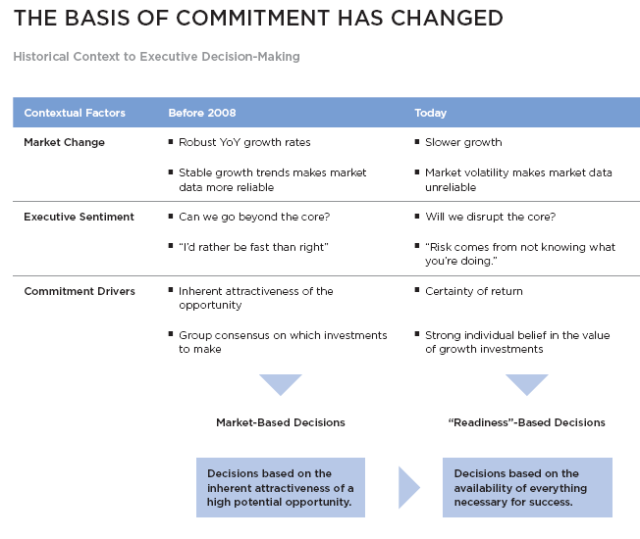
There also seems a shift in strategic approaches.
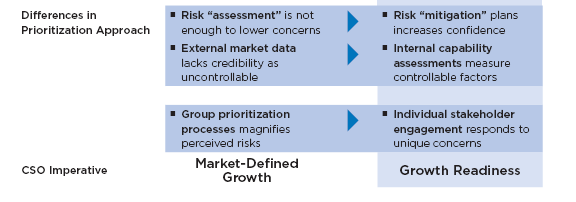
To prioritize investments based on growth readiness, strategists must consider the three enablers of growth readiness, Risk Readiness, Capability Readiness and Stakeholder Readiness.
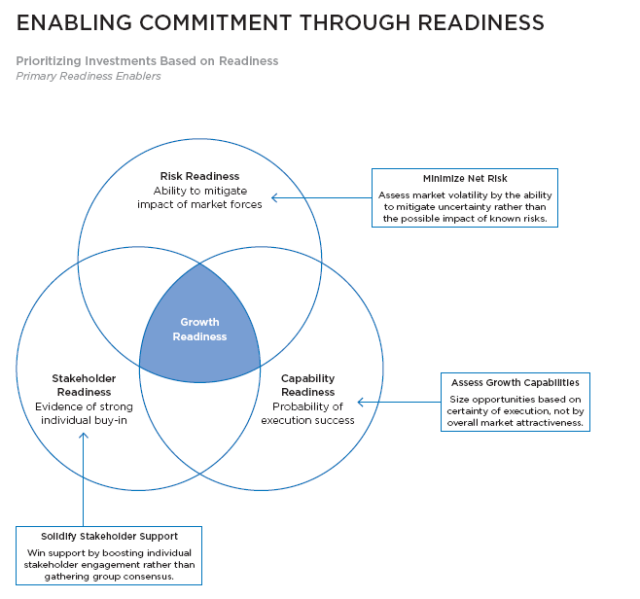
Equating the two reports
Although the interview ‘universe’ is different, one is global (PwC), one more contained in the USA (CEB) I think they justify this need to be brought together as risk readiness and growth through innovation need this equating.
I think reading both the PwC report “Breakthrough innovation and growth” alongside the CEB one on “Growth readiness” needs some narrowing of the dealing with risk, innovation and readiness, if companies actually determined to really work towards radical or breakthrough innovation.
I think the present mind set of risk mitigation might need some thoughtful thinking through and the discussion about risk readiness needs to take place within boardrooms if they are about to deploy innovation in greater ways.
Otherwise risk will impede innovation and then frustration then grows with innovation failing to deliver the expected results. The real frustration has actually as its real source the inabilities to quantify ‘acceptable’ risk and not having guidelines.
Innovation is inherently risky from often its inadequate data and market quantification. Clarification at board room level needs to be made on how to treat innovation when it is pursuing more radical, new business model or breakthrough approaches.
Strategic planning for innovation will need different thinking and tools to manage it adequately.
An early board room discussion should be about achieving a consensus over the growing recognition that innovation, at its most powerful, is a driver for rapid and profitable revenue growth but what will be the acceptable risks.
If companies are targeting a higher proportion of breakthrough and radical innovations, particularly around products, services, technology and business models, it can dramatically deliver improved competitive positioning, higher customer satisfaction, and decreased costs with the right innovation solutions, but it has risk.
Risk mitigation needs to equate as much of the uncertainties you find in exploring a breakthrough or radical approach to business. These discussions will have some high tension points, that need clearer guidelines otherwise we continue with growing strategic and innovation frustrations. The board needs to lead here.
Many of the challenges arise from the way innovation is managed and handled. Another early strategic boardroom discussion should be around the operating models and metrics for ‘business as usual’. These will conflict with those needed to drive innovation for ‘new growth business’.
Risk readiness needs to be well thought through, otherwise more radical or breakthrough innovation will struggle to get out of the door, let alone into the board room, if risk is not equated differently going forward. Risk versus opportunity needs to be constantly evaluated.
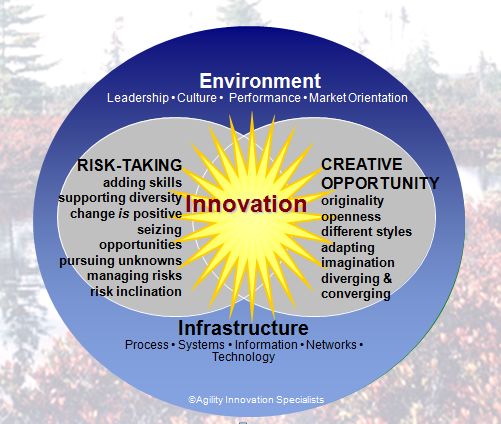
Agility Innovation Specialists
It will be the ones that can articulate the value, create the right narratives for this innovation growth, by taking these bolder approach decisions to innovation will less than perfect data.
They will succeed in gaining organic growth through innovation by understanding its parts in detail. It is those who can equally manage uncertainty by advocating a new risk readiness pathway to growth will be in better shape to pursue a broader innovation approach.
We will need to ‘marry’ risk and opportunity through our innovation activities far better and prompt some very important board room discussions to enable innovation to take this centre stage for growth.
CEB retains any and all intellectual property rights in these materials and requires retention of the copyright mark on all pages reproduced. © 2013 The Corporate Executive Board Company.
PwC also maintains the copyright over the material shown. © 2013 PwC. All rights reserved.